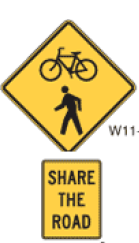Friday, August 31, 2012
|
John O’Brien, (850)
414-4573;
|
FDOT Commits to Full Funding of
Safe Routes to Schools and Recreational Trails
Safe Routes to Schools and Recreational Trails
Florida will use flexibility available in the
federal MAP-21
legislation to balance transportation needs
Tallahassee – The Florida Department of Transportation (FDOT) will continue to fully
fund Safe Routes to Schools and recreational trails in Florida thanks to the
flexibility included in the new federal Moving Ahead for
Progress in the 21st Century Act (MAP-21) legislation.
Despite funding cuts in the
Transportation Alternatives section of the bill, FDOT will commit to funding these two programs at prior year levels. The
flexibility in MAP-21 allows the Department to address one of its top
priorities: making Florida a safer state for bicyclists and pedestrians.
“We are redoubling our efforts to improve safety for bicyclists
and pedestrians in Florida,” said FDOT Secretary Ananth Prasad. “That’s why we
are fully funding these important programs.”
In an effort to
ensure Florida can maximize the use of its federal funds for projects that are
ready to go and to ensure flexibility, Florida Governor Rick Scott today sent a
letter to U.S. Secretary of Transportation Ray LaHood to opt out of a funding
provision in the MAP-21 legislation.
“This
action should in no way be viewed as an indication that Florida does not
support recreational trails,” said Secretary Prasad.
“Florida offers a year-around opportunity for our residents and visitors to
enjoy our great state as cyclists and pedestrians. We want to make their
experiences as safe and enjoyable as possible.”
The
Office of Greenways & Trails within the Florida Department of Environmental
Protection provides statewide leadership and coordination in the establishment,
expansion and promotion of the Florida Greenways and Trails System (FGTS). More
than $24 million in grants have been awarded for Florida recreational trails in
the past. FGTS will continue to administer the program using transportation
funding.
A new category of
federal transportation funding called Transportation Alternatives was created
in MAP-21. Eligible uses for these funds include bicycling, pedestrian
facilities and recreational trails which were previously funded by separate
programs. While Florida’s total funding for Transportation Alternatives will be
less than the combination of funding for the prior separately funded programs,
FDOT will use the funding flexibility in MAP-21 to fully fund Safe Routes to
Schools and recreational trails.
Details of the MAP-21
legislation and what it means for Florida will be explained in a two-part
Webinar being conducted by the Florida Department of Transportation on
September 5, 2012. For more information,
please go to MAP-21-FL.com.
Consistent,
Predictable, Repeatable
Click here for the letter from Governor Scott to Secretary LaHood.
Click here to read article in 9/1 Florida Current
Click here to read 9/2 Orlando article.
.




















